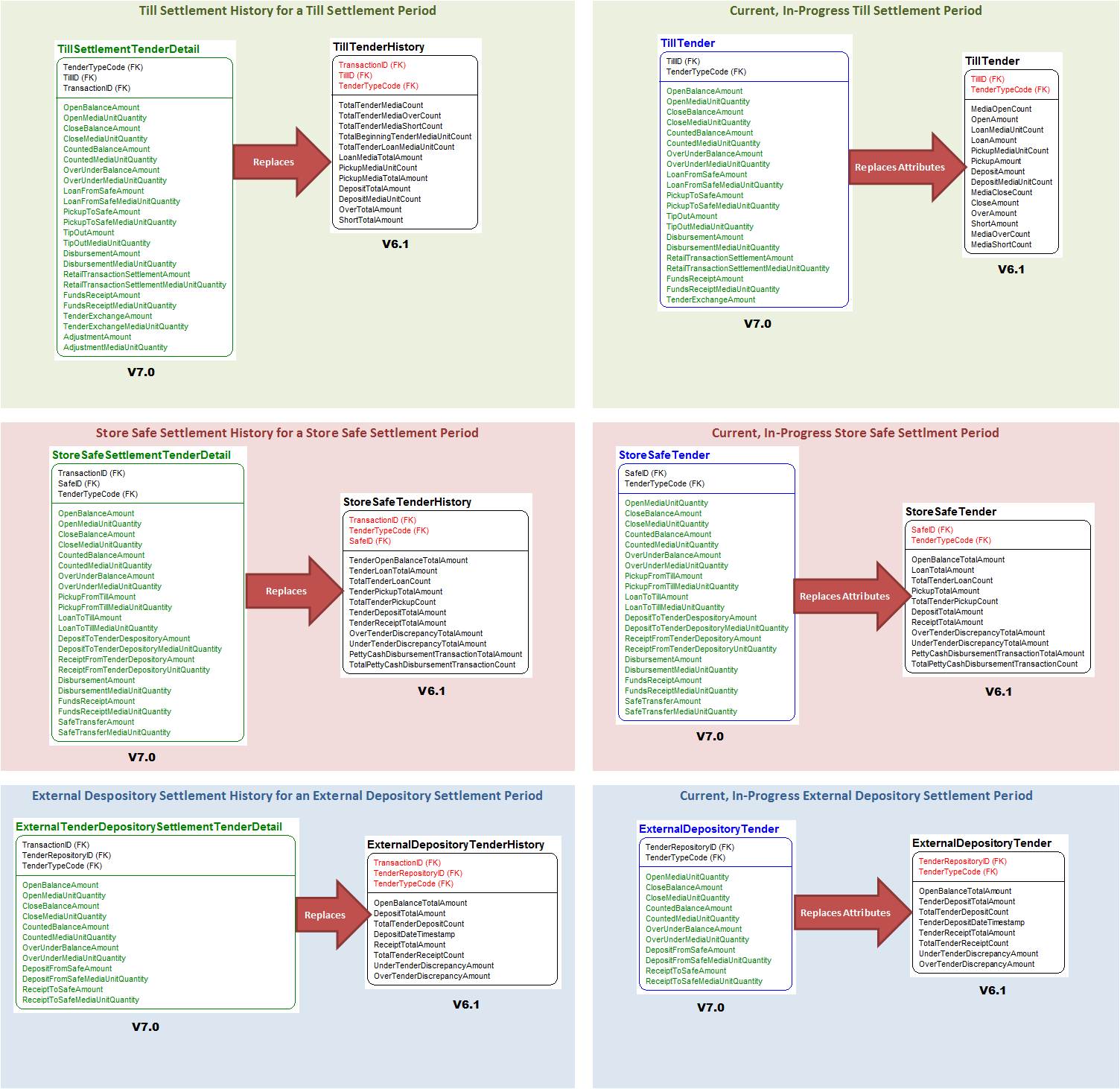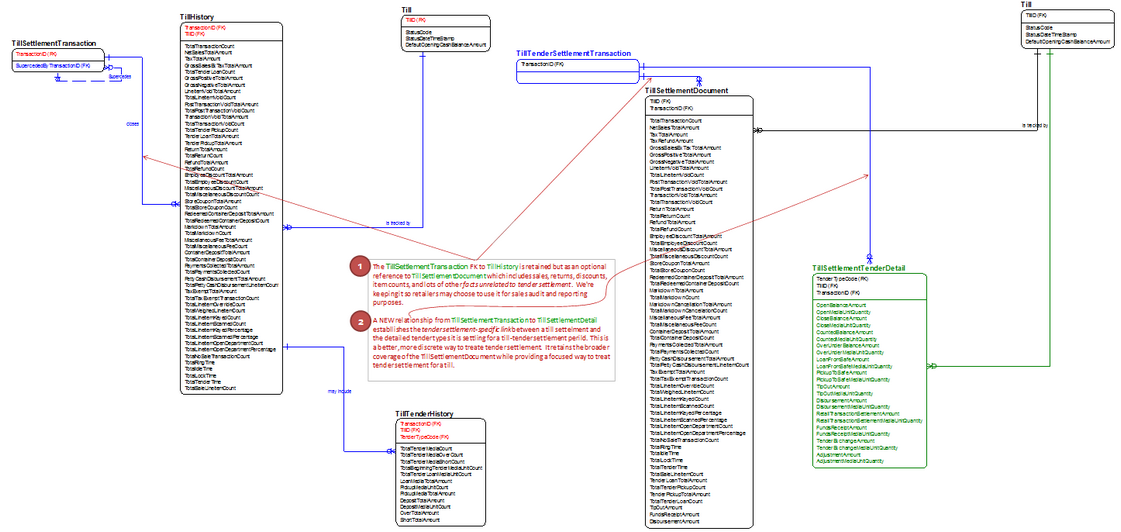Revised Entity Diagram Presentation ARTS ODM V7.0 through ODM V7.3 incorporate fully attributed entity diagrams in its narrative. In prior releases, the entity diagrams were represented at the entity level only. Also, because the narrative is implemented as HTML, the diagrams are larger and can be reviewed by panning around the diagram in the web browser. Color coded regions and supplementary note help diagram readers to focus on key areas of the diagrams as well as to group entities based on key relationships and business functions. ARTS ODM V7.2 to V7.3 Incremental Modifications and Improvements This new release of the ARTS ODM introduces a number of incremental improvements that correct errors and fill in missed entities and attributes. It includes meta data changes to object definitions and other properties. The Detailed ARTS 7.2 To 7.3 Changes presents a detailed list of specific name, physical name, domain and definition changes implemented on V7.3. In addition to these detailed changes, a number of key subject area diagrams include colored blocks to highlight closely related entity types and help orient the reader to a subject area. ARTS ODM V7.1 to V7.2 Modifications and Improvements Version 7.2 of the ARTS ODM makes incremental improvements and corrections to V7.1. •Clarified GiftCertificateClass.GiftCertificateTypeCode definition; •Added missing sequence number in CustomerOrderControlTransactionLineItem entity type; •Extended length of eMail Address attributes to 253 bytes; •Replaced Unit of Measure English-Metric Flag in UnitOfMeasure entity with a new entity and foreign key reference (MeasurementSystem.MeasurementSystemID); •Added a role name to the FK relationship from the FulfillmentAcknowledgementLineItem entity to the SaleReturnLineItem to clarify the idea that the sale return (i.e. merchandise) item in a retail transaction is derived from the fulfillment of a customer order line item; •Added FK from ItemCountryOrigin to ISO3166-1Country. Modified name of CountryOriginType to CountryOriginRoleType . This is to clarify the purpose of CountryOriginType which explains the nature of the country's designation as a place where an item came from. For example a food item may be grown in Thailand and canned in China and subsequently imported to the US. In this scenario, Thailand and China both represent different sources of the food item. This change helps to understand the nature of the sourcing role played by a country; •Added two new entities. Logo which maintains the logo URI reference and name information and DigitalAssetFormatType that qualifies the binary format used as a source to render the logo. The Logo entity is referenced in Transaction as a foreign key; •Added a definition for ODM72 Site.RetailSiteTypeCode; •Added a foreign key from CustomerSurvey to RetailTransaction. This optional relationships allows retailers the option of treating surveys separately OR as part of a retail transaction. Survey requirement; •Add an optional FK from ItemSalesSummary to PromotionalOfferHistory. Through joins this will link sales facts to the promotional initiative and offer descriptive data; •Add minimum advertised retail unit price to ItemSellingPrices; •Beginning with ODM V7.2 a unique SessionID attribute will replace the ID_TRN_SSN_SRT attribute in the primary key of the Session entity. This separates session ID from transaction ID and will solve the problem of a circular reference that may be encountered when generating a physical database; •Reversed relationship between DonationLineItem and Contribution to make ODM handling of charitable contributions consistent with CHANGE FOR CHARITY XML 1.0. In the revised model, a DonationLineItem is captured as part of a retail transaction and Contribution represents its assignment to a specific charity (and donation processor); •Added CustomerReturnAuthorizationNumber owned attribute to ReturnLineItem entity; •Added a CreditMemoFlag owned attribute to CustomerAccountInvoice to indicate that the document is a negative invoice (aka credit memo); •Modified the Logical 07200 - Customer Purchase Transaction History View by including the CustomerAccountInvoice entity. Modified the CustomerAccountInvoice entity by adding a CreditMemoFlag which provides a flag to distinguish between charge sales and credit refund activity. Also added a RefundFlag to the PaymentOnAccountLineItem that is used to associate customer account activity with specific retail transactions. •Minor correction of spelling errors and diagram formatting. ARTS ODM V7.0 to V7.1 Modifications and Improvements Version 7.1 of the ARTS ODM is a more modest extension of the data model than Version 7.0. From a business content standpoint the data model is extended to address: •Change for Charity - adds support for customer donations as part of a retail transaction Logical 02341 - Retail Transaction - Change For Charities; •Price Services Coupon Disposition - adds attributes needed to account for returned discount coupons Logical 02333 - Retail Transaction - Tender - Coupon View; and • Location Extension - Adds entities and attributes to implement location-specific coordinates Logical 10108 - Enterprise Geolocation. In addition a number of technical corrections and improvements are incorporated into ODM V7.1. These include: •Rationalization and alignment of domain assignment for identification attribute types; •Numerous spelling corrections and other similar remedial modifications ARTS ODM V6.1 to V7.0 Modifications and Improvements Revised Party and Party Role Assignment The modeling approach used to represent different kinds of Party is substantially different in ARTS ODM V7.0 from prior versions. The direct subtyping of a Party based on its role is dropped and replaced by a more appropriate subtyping based on PartyRoleAssignment. The reason for this change is that classifying Party based on role is a misrepresentation of what distinguishes one Party from another. The prior releases of ARTS mixed subtyping of parties based on whether a party is a person or organization as well as the role played in the retail business. In ARTS V7.0 these two ways of categorizing parties are separated. The Party - Revised Approach to Modeling Party topic explains the revised representation of party subtype in detail. Added Contact Methods and Related Descriptive Data The Logical - 06320 - Party - Address and Contact View subject area presents the new contact methods and related data added to ARTS ODM V7.0. The proliferation of internet channels and mobile channels is increasing the number of options retailers and customers have to exchange information. In V7.0 WebSite and SocialNetworkHandle contact methods have been appended to phone, address and email methods. Revised Tender Settlement Entities and Attributes The representation of tender settlement transactions is changed from ARTS ODM V6.1. The modification improves the consistency of how tender settlement transactions and their associated detail attributes are defined. The modifications are visible in several different subject areas. The primary subject area where the changes are implemented is the Logical 02520 - Tender Control Transaction - Settlement View. The changes include: •Replacement and renaming of entities; •Re-defining attributes to enforce a consistent way of representing tender settlement detail; and •Modification of relationships. Replacement/Rename of EntitiesRename V6.1 TillHistory entity to TillSettlementDocument in V7.0; Replace V6.1 TillTenderHistory entity to TillSettlementTenderDetail in V7.0; Rename V6.1 StoreSafeHistory entity to StoreSafeSettlementDocument in V7.0; Replace V6.1 StoreSafeTenderHistory to StoreSafeSettlementTenderDetail in V7.0 Rename V6.1 ExternalDepositoryTenderHistory to ExternalDepositoryDocument in V7.0 Replace V6.1 ExternalDepositoryTenderHistory to ExternalTenderDepositorySettlementTenderDetail in V7.0 These changes reflect the summarization of tender activity between tender settlement transactions for each tender repository and tender type. TillTender, StoreSafeTender and ExternalDepositoryTender each maintain cumulative totals for their respective tender repositories for the current (i.e., in-process) tender settlement period. The entry of a TillTenderSettlementTransaction, StoreSafeTenderSettlementTransaction or an ExternalDepositorySettlementTransaction triggers an settlement transaction control break process that takes a snapshot of the appropriate current tender balance, copies it into the appropriate settlement document and settlement document detail entity, moves the ending balance to the beginning balance and clears the cumulative totals for the new current period. Redefining AttributesThe tender repository history entity owned attributes in V6.1 are inconsistently named and defined. This inconsistency makes it difficult to figure out how attributes for one tender repository type map to the attributes for a different tender repository type. The ARTS ODM V7.0 replaced the repository tender history entity attributes with a new set of consistently named and defined attributes. The TillTenderHistory, StoreSafeTenderHistory and ExternalDepositoryTenderHistory entities as already discussed are replaced by new entities. These new entities also introduce the new, rationalized more consistent attributes used to capture tender settlement detail monetary values and counts. The replacement is a "wholesale" deletion of the old attributes and the insertion of new attributes. This attribute replacement applies to the current tender settlement period entities as well as the tender settlement document entities. Figure 6 - Tender Settlement Attribute Changes from V6.1 to V7.0
The detailed entity and attribute metadata for the V7.0 entities shown here are accessible from the Logical 02520 - Tender Control Transaction - Settlement View. Modification of RelationshipsThe Tender Settlement Entity Relationship Change diagram shows the V6.1 model on the left and the V7.0 model on the right. The change is described in the text block in the middle of the diagram. Functionally this is an addition to the V6.1 data model. This modification presents a more correct, consistent treatment of tender settlement and separates it from a broader till settlement. Figure 7- Tender Settlement Entity Relationship Change
These are the major changes implemented in ARTS ODM 7.0. There are a number of other smaller changes related to definition changes, spelling corrections and the like. The next topic, Change Audit Detailed Lists enumerates all changes by doing an object-level compare between V7.0 and V6.1 of the data models. Gemini Change Tracking Modifications ARTS maintains a change request tracking system called Gemini. This system is used to log questions, report data model and XML issues and track their resolution. A number of the data model issues have been addressed in this new version of the ODM. There are, however, open issues to be resolved. These issues will be addressed as part of an overall review of ARTS data model and XML standards with the intent of improving semantic consistency and correcting/clarifying the models. The nature of the issues raised in Gemini varies from spelling errors to requests for new subject areas. Because of the different levels of effort involved in the Gemini requests, ARTS attempts to schedule work that mixes major extensions and incremental bug fixes and perfective maintenance into its different standards releases. The table here lists specific issues resolved in ODM Version 7. Data Model Gemini Issues Resolved in ODM Version 7.0
|

